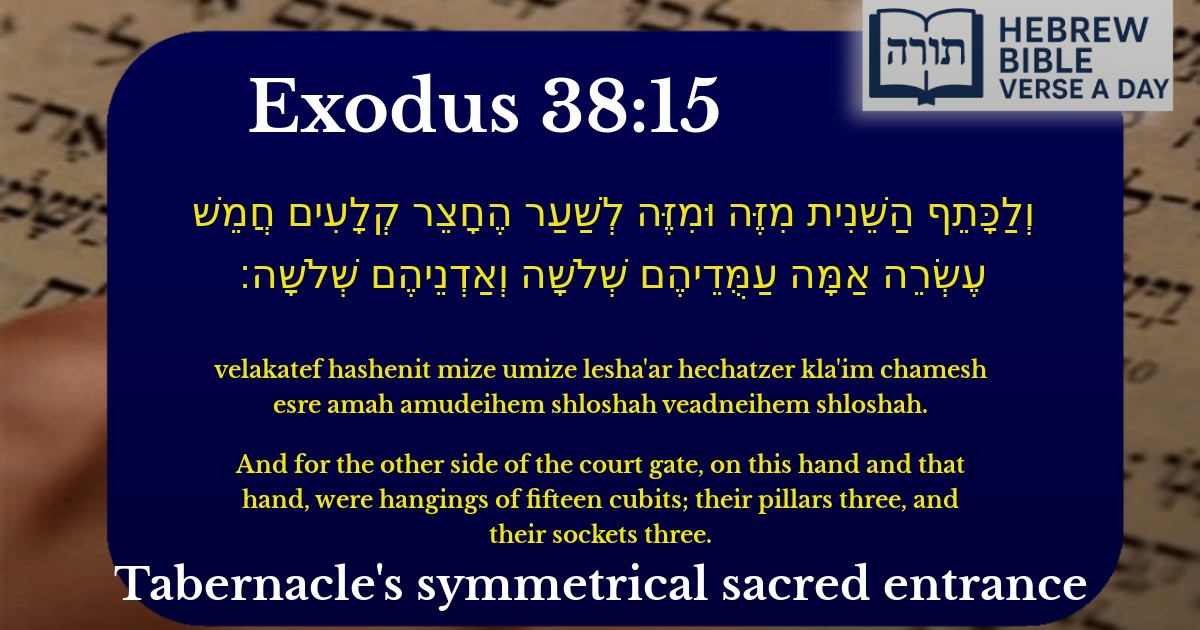Join Our Newsletter To Be Informed When New Videos Are Posted
Join the thousands of fellow Studends who rely on our videos to learn how to read the bible in Hebrew for free!
Hebrew Text
וְלַכָּתֵף הַשֵּׁנִית מִזֶּה וּמִזֶּה לְשַׁעַר הֶחָצֵר קְלָעִים חֲמֵשׁ עֶשְׂרֵה אַמָּה עַמֻּדֵיהֶם שְׁלֹשָׁה וְאַדְנֵיהֶם שְׁלֹשָׁה׃
English Translation
And for the other side of the court gate, on this hand and that hand, were hangings of fifteen cubits; their pillars three, and their sockets three.
Transliteration
Velakatef hashenit mize umize lesha'ar hechatzer kla'im chamesh esre amah amudeihem shloshah veadneihem shloshah.
Hebrew Leining Text
וְלַכָּתֵ֣ף הַשֵּׁנִ֗ית מִזֶּ֤ה וּמִזֶּה֙ לְשַׁ֣עַר הֶֽחָצֵ֔ר קְלָעִ֕ים חֲמֵ֥שׁ עֶשְׂרֵ֖ה אַמָּ֑ה עַמֻּדֵיהֶ֣ם שְׁלֹשָׁ֔ה וְאַדְנֵיהֶ֖ם שְׁלֹשָֽׁה׃
Parasha Commentary
📚 Talmud Citations
This verse is not quoted in the Talmud.


Context in the Mishkan
This verse (Exodus 38:15) describes the construction of the hangings (kelaim) for the courtyard (chatzer) of the Mishkan (Tabernacle). The hangings were made of fine linen and supported by pillars (amudim) with sockets (adanim). The specific measurements and arrangements reflect the precision required in building the sacred space where the Divine Presence would dwell.
Measurement and Symmetry
Rashi explains that the "other side" refers to the western side of the courtyard, parallel to the eastern entrance. The hangings measured 15 cubits in length, with three pillars and three sockets supporting them. This symmetry emphasizes balance and order in the Mishkan's design, mirroring the harmony of Creation.
Significance of the Number Three
The Talmud (Yoma 33b) notes that the number three appears frequently in the Mishkan's construction, symbolizing:
Pillars and Sockets
The Rambam (Hilchot Beit HaBechirah 1:12) draws a parallel between the Mishkan's pillars and the future Beit HaMikdash, noting that the sockets (adanim) represent stability. The Ibn Ezra adds that the pillars' silver material (as mentioned in earlier verses) signifies purity and dedication to divine service.
Spiritual Lessons
The Midrash (Shemot Rabbah 35:1) teaches that the courtyard's structure reflects the boundaries of holiness in a person's life. Just as the hangings separated the sacred from the mundane, we must establish spiritual boundaries to elevate our daily actions.